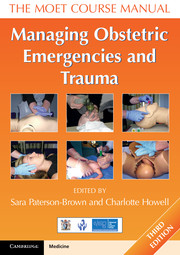Book contents
- Frontmatter
- Dedication
- Contents
- Working Group
- About the authors
- Acknowledgements
- Abbreviations
- Section 1 Introduction
- Section 2 Recognition
- Section 3 Resuscitation
- Section 4 Trauma
- Section 5 Other medical and surgical emergencies
- Section 6 Obstetric emergencies
- 24 Pre-eclampsia and eclampsia
- 25 Major obstetric haemorrhage
- 26 Caesarean section
- 27 Placenta accreta and retained placenta
- 28 Uterine inversion
- 29 Ruptured uterus
- 30 Ventouse and forceps delivery
- 31 Shoulder dystocia
- 32 Umbilical cord prolapse
- 33 Face presentation
- 34 Breech delivery and external cephalic version
- 35 Twin pregnancy
- 36 Complex perineal and anal sphincter trauma
- 37 Symphysiotomy and destructive procedures
- 38 Anaesthetic complications in obstetrics
- Section 7 Triage and transfer
- Section 8 Human issues
- Index
33 - Face presentation
- Frontmatter
- Dedication
- Contents
- Working Group
- About the authors
- Acknowledgements
- Abbreviations
- Section 1 Introduction
- Section 2 Recognition
- Section 3 Resuscitation
- Section 4 Trauma
- Section 5 Other medical and surgical emergencies
- Section 6 Obstetric emergencies
- 24 Pre-eclampsia and eclampsia
- 25 Major obstetric haemorrhage
- 26 Caesarean section
- 27 Placenta accreta and retained placenta
- 28 Uterine inversion
- 29 Ruptured uterus
- 30 Ventouse and forceps delivery
- 31 Shoulder dystocia
- 32 Umbilical cord prolapse
- 33 Face presentation
- 34 Breech delivery and external cephalic version
- 35 Twin pregnancy
- 36 Complex perineal and anal sphincter trauma
- 37 Symphysiotomy and destructive procedures
- 38 Anaesthetic complications in obstetrics
- Section 7 Triage and transfer
- Section 8 Human issues
- Index
Summary
Objectives
On successfully completing this topic, you will be able to:
understand the mechanics of delivery of the baby presenting by the face
appreciate the importance of the positioning of the face in labour and prior to delivery
understand how to assess the situation when contemplating operative vaginal delivery.
Introduction
Face presentation occurs in approximately 1/500 to 1/1000 deliveries.
Aetiology
Predisposing causes are characteristics that reduce cephalic flexion and include the following:
• multiparity
• prematurity
• multiple pregnancy
• loops of cord around neck
• neck tumours
• uterine abnormalities
• cephalopelvic disproportion
• fetal macrosomia.
Clinical approach
Diagnosis
Primary face presentation might be detected on a late ultrasound scan. The majority of face presentations are secondary and arise in labour.
Abdominal examination
A large amount of head is palpable on the same side as the back, without a cephalic prominence on the same side as the limbs, before the head has entered the pelvis.
Vaginal examination
In early labour, the presenting part will be high. At vaginal examination (VE), landmarks are the mouth, jaws, nose, malar and orbital ridges. The presence of alveolar margins distinguishes the mouth from the anus, so distinguishing a face presentation from that of a breech. In addition, the mouth and the maxillae form the corners of a triangle, while in a breech presentation, the anus is on a straight line between the ischial tuberosities.
During VE, avoid inadvertently damaging the eyes by trauma or antiseptics.
- Type
- Chapter
- Information
- Managing Obstetric Emergencies and TraumaThe MOET Course Manual, pp. 389 - 394Publisher: Cambridge University PressPrint publication year: 2014

